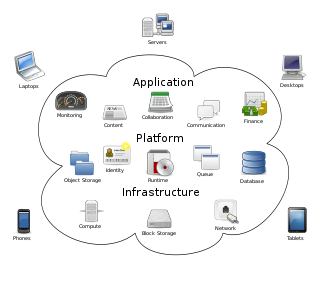
Image sharing, or photo sharing, is the publishing or transfer of digital photos online. Image sharing websites offer services such as uploading, hosting, managing and sharing of photos. This function is provided through both websites and applications that facilitate the upload and display of images. The term can also be loosely applied to the use of online photo galleries that are set up and managed by individual users, including photoblogs. Sharing means that other users can view but not necessarily download images, and users can select different copyright options for their images.

Edge computing is a distributed computing model that brings computation and data storage closer to the sources of data. More broadly, it refers to any design that pushes computation physically closer to a user, so as to reduce the latency compared to when an application runs on a centralized data centre.
Cloud storage is a model of computer data storage in which data, said to be on "the cloud", is stored remotely in logical pools and is accessible to users over a network, typically the Internet. The physical storage spans multiple servers, and the physical environment is typically owned and managed by a cloud computing provider. These cloud storage providers are responsible for keeping the data available and accessible, and the physical environment secured, protected, and running. People and organizations buy or lease storage capacity from the providers to store user, organization, or application data.
Platform as a service (PaaS) or application platform as a service (aPaaS) or platform-based service is a cloud computing service model where users provision, instantiate, run and manage a modular bundle of a computing platform and applications, without the complexity of building and maintaining the infrastructure associated with developing and launching application(s), and to allow developers to create, develop, and package such software bundles.
Dropbox is a file hosting service operated by the American company Dropbox, Inc., headquartered in San Francisco, California, U.S. that offers cloud storage, file synchronization, personal cloud, and client software. Dropbox was founded in 2007 by MIT students Drew Houston and Arash Ferdowsi as a startup company, with initial funding from seed accelerator Y Combinator.

Cloud computing is the on-demand availability of computer system resources, especially data storage and computing power, without direct active management by the user. Large clouds often have functions distributed over multiple locations, each of which is a data center. Cloud computing relies on sharing of resources to achieve coherence and typically uses a pay-as-you-go model, which can help in reducing capital expenses but may also lead to unexpected operating expenses for users.

Microsoft Azure, or just Azure, is the cloud computing platform developed by Microsoft. It has management, access and development of applications and services to individuals, companies, and governments through its global infrastructure. It also provides capabilities that are usually not included within other cloud platforms, including software as a service (SaaS), platform as a service (PaaS), and infrastructure as a service (IaaS). Microsoft Azure supports many programming languages, tools, and frameworks, including Microsoft-specific and third-party software and systems.

AppScale is a software company that offers cloud infrastructure software and services to enterprises, government agencies, contractors, and third-party service providers. The company commercially supports one software product, AppScale ATS, a managed hybrid cloud infrastructure software platform that emulates the core AWS APIs. In 2019, the company ended commercial support for its open-source serverless computing platform AppScale GTS, but AppScale GTS source code remains freely available to the open-source community.
RockYou was a company that developed widgets for MySpace and implemented applications for various social networks and Facebook. Since 2014, it has engaged primarily in the purchases of rights to classic video games; it incorporates in-game ads and re-distributes the games.
Photodex was a software company specializing in the digital imaging market. They are primarily known for the ProShow product line, which is photo slideshow software.

Magisto is a technology company founded in 2009 to provide artificial intelligence (AI) technology for video editing. It produces an online video editor of the same name for automated video editing and production aimed at consumers and businesses. The company was acquired by Vimeo in 2019 for an estimated US$200 million.
Backend as a service (BaaS), sometimes also referred to as mobile backend as a service (MBaaS), is a service for providing web app and mobile app developers with a way to easily build a backend to their frontend applications. Features available include user management, push notifications, and integration with social networking services. These services are provided via the use of custom software development kits (SDKs) and application programming interfaces (APIs). BaaS is a relatively recent development in cloud computing, with most BaaS startups dating from 2011 or later. Some of the most popular service providers are AWS Amplify and Firebase.
Growth hacking is a subfield of marketing focused on the rapid growth of a company. It is referred to as both a process and a set of cross-disciplinary (digital) skills. The goal is to regularly conduct experiments, which can include A/B testing, that will lead to improving the customer journey, and replicate and scale the ideas that work and modify or abandon the ones that do not, before investing a lot of resources. It started in relation to early-stage startups that need rapid growth within a short time on tight budgets, and also reached bigger corporate companies.

Promo.com is a cloud-based video creation service. It allows the creation of videos from stock videos, photos, video clips, and music. The company has offices in Warsaw, New York City, and Tel Aviv.
Google Cloud Platform (GCP) is a suite of cloud computing services offered by Google that provides a series of modular cloud services including computing, data storage, data analytics, and machine learning, alongside a set of management tools. It runs on the same infrastructure that Google uses internally for its end-user products, such as Google Search, Gmail, and Google Docs, according to Verma et al. Registration requires a credit card or bank account details.
Firebase was a company that developed backend software. It was founded in San Francisco in 2011 and was incorporated in Delaware.
Autoscaling, also spelled auto scaling or auto-scaling, and sometimes also called automatic scaling, is a method used in cloud computing that dynamically adjusts the amount of computational resources in a server farm - typically measured by the number of active servers - automatically based on the load on the farm. For example, the number of servers running behind a web application may be increased or decreased automatically based on the number of active users on the site. Since such metrics may change dramatically throughout the course of the day, and servers are a limited resource that cost money to run even while idle, there is often an incentive to run "just enough" servers to support the current load while still being able to support sudden and large spikes in activity. Autoscaling is helpful for such needs, as it can reduce the number of active servers when activity is low, and launch new servers when activity is high. Autoscaling is closely related to, and builds upon, the idea of load balancing.
"X as a service" is a phrasal template for any business model in which a product use is offered as a subscription-based service rather than as an artifact owned and maintained by the customer. Originating from the software as a service concept that appeared in the 2010s with the advent of cloud computing, the template has expanded to numerous offerings in the field of information technology and beyond it. The term XaaS can mean "anything as a service".
Visual Cloud is the implementation of visual computing applications that rely on cloud computing architectures, cloud scale processing and storage, and ubiquitous broadband connectivity between connected devices, network edge devices and cloud data centers. It is a model for providing visual computing services to consumers and business users, while allowing service providers to realize the general benefits of cloud computing, such as low cost, elastic scalability, and high availability while providing optimized infrastructure for visual computing application requirements.









